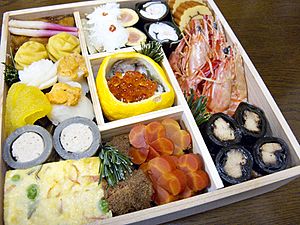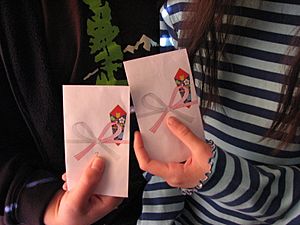Japanese New Year facts for kids
Quick facts for kids Japanese New Year (Oshogatsu) |
|
|---|---|

The kadomatsu is a traditional decoration for the new year holiday.
|
|
| Official name | Shōgatsu (正月) or Oshogatsu |
| Also called | new year |
| Observed by | Japanese |
| Type | Cultural |
| Significance | Celebrates the new year |
| Observances | Holiday |
| Begins | December 31/January 1 |
| Ends | January 4 |
| Date | January 1 |
| Next time | 1 January 2026 |
| Frequency | annual |
| Related to | New Year's Day, Chinese New Year, Korean New Year, Vietnamese New Year, Mongolian New Year, Tibetan New Year |
The Japanese New Year is called Oshogatsu. It's one of Japan's most important holidays. Long ago, Japanese New Year was celebrated at the start of spring, like in China and Korea. But since 1873, Japan celebrates New Year's Day on January 1st, just like many other countries. This special time has many unique traditions that have been celebrated for hundreds of years.
Contents
Special New Year's Food
On New Year's Day, Japanese families eat special dishes called osechi. These foods are often sweet or sour. This helped them stay fresh longer in the past, before refrigerators were common. Stores used to close for about a week during the holiday.
Some popular osechi foods include:
- Zōni: This is a miso soup with mochi (sticky rice cakes) and vegetables.
- Kobumaki: Tuna fish wrapped in sweet, boiled kelp.
- Kamaboko: A type of fish paste that looks like jelly.
- Kurikinton: Mashed sweet potato mixed with chestnut.
- Kuromame: Sweetened black beans.
Today, people also enjoy sashimi and sushi during the New Year. To give their stomachs a rest after all the rich food, many Japanese eat Nanakusa gayu on the 7th day. This is a light rice soup with seven different vegetables. Eating these special foods is a big part of the New Year's joy in Japan.
New Year's Postcards
Sending New Year's postcards is a popular Japanese tradition. It's a bit like sending Christmas cards. These postcards are called nengajo. People send them so they arrive exactly on January 1st. The post office works hard to make sure this happens. They even hire students part-time to help deliver all the cards. The end of December and early January are the busiest times for the Japanese post office.
If someone in a family has passed away during the year, it's customary not to send joyful nengajo. Instead, they send a simple card to let friends and family know not to send New Year's greetings. This shows respect for the person who died.
Many nengajo cards feature the Chinese Zodiac animal for the new year. The Chinese zodiac has a 12-year cycle, with each year represented by a different animal. The animals are: mouse, cow, tiger, rabbit, dragon, snake, horse, sheep, monkey, rooster, dog, and boar. For example, 2018 was the year of the dog. Even with email being so popular, sending nengajo remains a very important tradition in Japan.
Otoshidama: New Year's Money Gifts
On New Year's Day, children in Japan receive special pocket money called otoshidama. This tradition comes from China. The money is given in small, decorated envelopes called pochibukuro. Long ago, during the Edo period, large stores and wealthy families would give out small bags of mochi and Mandarin oranges to spread happiness.
Today, the amount of money given depends on the child's age. If there are several children in a family, they usually receive the same amount. This way, no one feels left out.
Making Mochi
Another fun Japanese New Year custom is making rice cakes. This sticky treat is made from boiled mochigome (sticky rice). The rice is placed in a wooden bucket-like container. One person pats the rice with water, while another person hits it with a large wooden hammer. This mashing makes the rice very sticky and forms a soft, white dumpling. Mochi is usually made before New Year's Day and eaten throughout early January.
Images for kids
-
Osechi-ryōri, typical new year's dishes
-
A traditionally ornamented kagami mochi
-
Coloured woodblock print of the Takarabune by Utagawa Hiroshige
See also
 In Spanish: Año nuevo japonés para niños
In Spanish: Año nuevo japonés para niños











